- Home
- Edgar Allan Poe
The Narrative of Arthur Gordon Pym of Nantucket Page 30
The Narrative of Arthur Gordon Pym of Nantucket Read online
Page 30
—An excerpt from the story “The Gold-Bug” (1843), in which one character explains to another how to decipher a message based on the encoding principles Poe had described earlier. “The Gold-Bug” won the Philadelphia Dollar Newspaper’s writing contest, earned Poe one hundred dollars, and was at the time one of his most widely read stories.
7. THE HOLLOW EARTH THEORY
Warm Weather at the South Pole
We had now advanced to the southward more than eight degrees farther than any previous navigators, and the sea still lay perfectly open before us. We found, too, that the variation uniformly decreased as we proceeded, and, what was still more surprising, that the temperature of the air, and latterly of the water, became milder. The weather might even be called pleasant, and we had a steady but very gentle breeze always from some northern point of the compass. The sky was usually clear, with now and then a slight appearance of thin vapour in the southern horizon—this, however, was invariably of brief duration. Two difficulties alone presented themselves to our view; we were getting short of fuel, and symptoms of scurvy had occurred among several of the crew. These considerations began to impress upon Captain Guy the necessity of returning, and he spoke of it frequently. For my own part, confident as I was of soon arriving at land of some description upon the course we were pursuing, and having every reason to believe, from present appearances, that we should not find it the sterile soil met with in the higher Arctic latitudes, I warmly pressed upon him the expediency of persevering, at least for a few days longer, in the direction we were now holding. So tempting an opportunity of solving the great problem in regard to an Antarctic continent had never yet been afforded to man, and I confess that I felt myself bursting with indignation at the timid and ill-timed suggestions of our commander.
—From Chapter XVII of Pym.
Theorizing the Hollow Earth
The earth is globular, hollow, and open at the poles. The diameter of the northern opening is about two thousand miles, or four thousand miles from outside to outside. The south opening is somewhat larger. The planes of these openings are parallel to each other, but form an angle of 12° with the equator, so that the highest part of the north plane is directly opposite the lowest part of the south plane. The shell of the earth is about one thousand miles thick, and the edges of this shell at the openings are called verges, and measure, from the regular concavity within to the regular convexity without, about fifteen hundred miles. The verges occupy about 25°, and if delineated on a map would show only the outer half of the verge, while all above or further from the equator, both north and south, would lie on the apex and within the verge. All the polar regions upon the present map would be out of sight. The meridian lines extend at right angles from the equator to the outer edges of the verges, and then wind round along the surface of the verges, terminating at the points directly under the highest parts of the verges both north and south.…
Captain Symmes collated with great labor many isolated facts from his own researches, and from the accounts of Ross, Howe, Parry, McKenzie, and others who had by sea and land explored the polar regions, while similar proofs have been drawn from later explorations since the promulgation of the theory in 1829.
The explorers who furnish facts for the support of this theory seem, none of them, to have had the remotest conjecture of it. The facts are admitted, and it can not be urged against its author that he has marshaled in its support fictitious premises. His arguments, drawn from the facts, may be erroneous. Yet it is true that many of them which have not as yet been otherwise satisfactorily explained are easily accounted for upon his theory.
There is a remarkable difference of climate under different meridians upon the same parallel of latitude. It is known that the climate of the eastern coast of North America is much colder than that of Western Europe in the same latitude. The notion that this diversity is produced by the proximity of the ocean or of ranges of mountains is unsatisfactory; for countries, similar in these respects, in the same latitude, have a great diversity of climate. A theory which would explain the mild climate of France and England from these causes would not suit the case of New York and New England and the cold regions around the Gulf of St. Lawrence south of 59° north latitude. The topography of these sections of country is similar; and yet England and France have a mild and genial climate, while New England and Newfoundland are cold and bleak in the winter. Labrador, not so far north as Great Britain, is a cold and bleak as countries in Europe 20° farther north.
The heat and cold of the different climates are governed by their distance from the verge of the polar opening, and do not depend on their nearness to or remoteness from the equator. The natural climates are parallel to the planes of the polar openings, and cut the parallels of latitude at an angle of twelve degrees. When the sun is on the tropic of Capricorn, the circle of greatest cold would be about twenty-three and a half degrees south of the apparent verge, and when the sun is on the tropic of Cancer this circle would probably be just under the umbrage of the real verge; hence it follows, if this doctrine be correct, that the climate of forty degrees north latitude on the plains of Missouri, in the western part of the continent of America, will be as cold in winter as the latitude of fifty or fifty-two degrees in Europe; and observation has fully confirmed such to be the fact.
The Gulf Stream does not satisfactorily account for this diversity of climate between America and Europe. Sweeping along the coast of the United States northeastwardly from the Gulf of Mexico, with its vast volume of water, why should it not moderate the climate of North America as well as that of Eastern Europe? After nearing the banks of Newfoundland, it deflects eastwardly across the Atlantic about two thousand miles, and then sends off one branch northeastwardly along the coast of Norway, and another down the western coast of Europe and Africa, till it is lost in the Southern Atlantic. Why, then, does not this mighty river of the ocean affect the climate of the United States as much or even more than that of France and England? It is claimed that this stream raises the climate of Europe 12° or 15° higher than that of the United States, whereas its effect should be greater upon the United States than upon Europe.
The characteristics of the isothermal belts of both hemispheres throw some light upon this theory. The region of the verges must be the coldest parts of the earth’s surface, because, being more convex, they diverge instead of converging the sun’s rays. The temperature, therefore, of any given part of the earth’s surface depends as well upon its proximity to the verge as to the equator. Europe, under the northern verge in latitude 60° N. would have the same climate with a place 70° west longitude, some six degrees farther south; and at 160° west longitude the climate would be some twelve degrees colder than that of England. This would be true as a general rule, subject, however, to many local exceptions arising from the elevation and direction of mountain ranges, or the proximity of the ocean or large bodies of water, or from other causes. Paris, 49° N., is about the same distance from the verge as Washington in latitude 30° N., and their latitude is nearly alike.
Thus, while this theory does not explain all the phenomena of climactic differences as indicated by the isothermal belts, it affords a general rule for explaining why the climate of Europe is milder than that of North America. The isothermal line of 32° of Fahrenheit, which marks the southern limit of frozen ground, as laid down on climactic charts, corresponds very neatly with the location of the northern verge.…
According to Symmes’ theory, a zone at a short distance beyond the real verge of the sphere (which constitutes the coldest part, or as he has thought proper to term it, “the icy circle”), commencing at the highest point, in about latitude sixty-eight degrees, in the northern sea, near Norway, thence gradually declining to about latitude fifty degrees in the Pacific Ocean, which is the lowest point, and thence regularly round again to the highest point. A certain distance beyond this, and short of the apparent verge, this zone or icy circle exists, which is believed to be the coldest region of the
earth. After passing this, we would advance into the interior of the globe and into a milder clime.
—From The Symmes Theory of Concentric Spheres, Demonstrating That the Earth Is Hollow, Habitable Within, and Widely Open About the Poles. Though John Cleves Symmes, Jr., described his Hollow Earth theory in an 1818 flyer directed “TO ALL THE WORLD,” he never wrote a book on his ideas. His follower James McBride wrote up The Symmes Theory in 1826, and Americus Symmes, John Cleves Symmes’s son, published it in 1878.
Fiction of the Hollow Earth
On the 28th of November, 1817, we discovered land, just at sunset, and immediately hove to, to keep a good offing until day-light. I walked the deck all night, and was very impatient for the morning of that day which was to disclose to me the wonders of the internal world, and probably to decide the question whether it was or was not inhabited by rational beings.
Happily, day soon appeared, and we ran in with the land, keeping a good look-out, and the leads constantly going. On nearing the coast, we found the shore to be low and sandy. The body of the land, however, was high, with one towering peak far inland. Near the sea it appeared to be extremely barren, but some miles back, scattered clumps of trees, and some appearances of verdure, afforded a more cheering prospect. We explored the coast of this island, for such it proved to be, for two days, before we found anchorage, or a safe landing place. A very heavy surf rolled on shore, and broke high on the shoals, which were frequent, and in some places three miles off the coast, so as to make it dangerous to approach. At length we found a safe road, sheltered by a sand bank above water, about two miles long, and lying parallel with the shore, half a league from it. There was a fair passage in, with 15 fathoms water, and good holding ground. Here we moored to the great joy of all on board, who, seeing firm land with living things of some kind moving about upon it, felt satisfied that they were still in the sublunary world, and complained of nothing but the excessive heat. It was near night when we came to anchor; all further research was therefore deferred until the next day.
On the 1st December, I landed for the first time on terra firma of the internal world.
—From Adam Seaborn’s 1820 novel Symzonia: Voyage of Discovery, in which the narrator travels into the interior of Earth and discovers an advanced civilization.
We must have traveled several miles through the dark and dismal wood when we came suddenly upon a dense village built high among the branches of the trees. As we approached it my escort broke into wild shouting which was immediately answered from within, and a moment later a swarm of creatures of the same strange race as those who had captured me poured out to meet us. Again I was the center of a wildly chattering horde. I was pulled this way and that. Pinched, pounded, and thumped until I was black and blue, yet I do not think that their treatment was dictated by either cruelty or malice—I was a curiosity, a freak, a new plaything, and their childish minds required the added evidence of all their senses to back up the testimony of their eyes.
Presently they dragged me within the village, which consisted of several hundred rude shelters of boughs and leaves supported upon the branches of the trees. Between the huts, which sometimes formed crooked streets, were dead branches and the trunks of small trees which connected the huts upon one tree to those within adjoining trees; the whole network of huts and pathways forming an almost solid flooring a good fifty feet above the ground.
I wondered why these agile creatures required connecting bridges between the trees, but later when I saw the motley aggregation of half-savage beasts which they kept within their village I realized the necessity for the pathways. There were a number of the same vicious wolf-dogs which we had left worrying the dyryth, and many goat-like animals whose distended udders explained the reason for their presence.
My guard halted before one of the huts into which I was pushed; then two of the creatures squatted down before the entrance—to prevent my escape, doubtless. Though where I should have escaped to I certainly had not the remotest conception.
I had no more than entered the dark shadows of the interior than there fell upon my ears the tones of a familiar voice, in prayer.
“Perry!” I cried. “Dear old Perry! Thank the Lord you are safe.”
“David! Can it be possible that you escaped?” And the old man stumbled toward me and threw his arms about me.
He had seen me fall before the dyryth, and then he had been seized by a number of the ape-creatures and borne through the tree tops to their village. His captors had been as inquisitive as to his strange clothing as had mine, with the same result. As we looked at each other we could not help but laugh.
“With a tail, David,” remarked Perry, “you would make a very handsome ape.”
“Maybe we could borrow a couple,” I rejoined. “They seem to be quite the thing this season. I wonder what the creatures intend doing with us, Perry. They don’t seem really savage. What do you suppose they can be? You were about to tell me where we are when that great hairy frigate bore down upon us—have you really any idea at all?”
“Yes, David,” he replied, “I know precisely where we are. We have made a magnificent discovery, my boy! We have proved that the earth is hollow. We have passed entirely through its crust to the inner world.”
“Perry, you are mad!”
“Not at all, David. For two hundred and fifty miles our prospector bore us through the crust beneath our outer world. At that point it reached the center of gravity of the five-hundred-mile-thick crust. Up to that point we had been descending—direction is, of course, merely relative. Then at the moment that our seats revolved—the thing that made you believe that we had turned about and were speeding upward—we passed the center of gravity and, though we did not alter the direction of our progress, yet we were in reality moving upward—toward the surface of the inner world. Does not the strange fauna and flora which we have seen convince you that you are not in the world of your birth? And the horizon—could it present the strange aspect which we both noted unless we were indeed standing upon the surface inside of a sphere?”
“But the sun, Perry!” I urged. “How in the world can the sun shine through five hundred miles of solid crust?”
“It is not the sun of the outer world that we see here. It is another sun—an entirely different sun—that casts its eternal noonday effulgence upon the face of the inner world. Look at it now, David—if you can see it from the doorway of this hut—and you will see that it is still in the exact center of the heavens. We have been here for many hours—yet it is still noon.”
—From Edgar Rice Burroughs’s At the Earth’s Core, which appeared serially in All-Story Weekly in April of 1914. The novel was the first in Burroughs’s fantasy series about a “hollow earth” land called Pellucidar.
When they came to the mountain it proved to be a rugged, towering chunk of deep green glass, and looked dismal and forbidding in the extreme. Half way up the steep was a yawning cave, black as night beyond the point where the rainbow rays of the colored suns reached into it.
The Mangaboos drove the horse and the kitten and the piglets into this dark hole and then, having pushed the buggy in after them—for it seemed some of them had dragged it all the way from the domed hall—they began to pile big glass rocks within the entrance, so that the prisoners could not get out again.
“This is dreadful!” groaned Jim. “It will be about the end of our adventures, I guess.”
“If the Wizard was here,” said one of the piglets, sobbing bitterly, “he would not see us suffer so.”
“We ought to have called him and Dorothy when we were first attacked,” added Eureka. “But never mind; be brave, my friends, and I will go and tell our masters where you are, and get them to come to your rescue.”
The mouth of the hole was nearly filled up now, but the kitten gave a leap through the remaining opening and at once scampered up into the air. The Mangaboos saw her escape, and several of them caught up their thorns and gave chase, mounting through the air after her. Eureka
, however, was lighter than the Mangaboos, and while they could mount only about a hundred feet above the earth the kitten found she could go nearly two hundred feet. So she ran along over their heads until she had left them far behind and below and had come to the city and the House of the Sorcerer. There she entered in at Dorothy’s window in the dome and aroused her from her sleep.
As soon as the little girl knew what had happened she awakened the Wizard and Zeb, and at once preparations were made to go to the rescue of Jim and the piglets. The Wizard carried his satchel, which was quite heavy, and Zeb carried the two lanterns and the oil can. Dorothy’s wicker suit-case was still under the seat of the buggy, and by good fortune the boy had also placed the harness in the buggy when he had taken it off from Jim to let the horse lie down and rest. So there was nothing for the girl to carry but the kitten, which she held close to her bosom and tried to comfort, for its little heart was still beating rapidly.
Some of the Mangaboos discovered them as soon as they left the House of the Sorcerer; but when they started toward the mountain the vegetable people allowed them to proceed without interference, yet followed in a crowd behind them so that they could not go back again.
Before long they neared the Black Pit, where a busy swarm of Mangaboos, headed by their Princess, was engaged in piling up glass rocks before the entrance.
“Stop, I command you!” cried the Wizard, in an angry tone, and at once began pulling down the rocks to liberate Jim and the piglets. Instead of opposing him in this they stood back in silence until he had made a good-sized hole in the barrier, when by order of the Princess they all sprang forward and thrust out their sharp thorns.

 The Works of Edgar Allan Poe — Volume 2
The Works of Edgar Allan Poe — Volume 2 The Works of Edgar Allan Poe — Volume 1
The Works of Edgar Allan Poe — Volume 1 The Works of Edgar Allan Poe — Volume 3
The Works of Edgar Allan Poe — Volume 3 The Works of Edgar Allan Poe — Volume 5
The Works of Edgar Allan Poe — Volume 5 The Works of Edgar Allan Poe — Volume 4
The Works of Edgar Allan Poe — Volume 4 The Tell-Tale Heart
The Tell-Tale Heart The Raven (Penguin)
The Raven (Penguin) The Paris Mysteries
The Paris Mysteries Tales of Terror from Edgar Allan Poe
Tales of Terror from Edgar Allan Poe The Fall of the House of Usher
The Fall of the House of Usher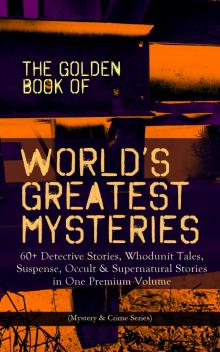 The Golden Book of World's Greatest Mysteries
The Golden Book of World's Greatest Mysteries The Narrative of Arthur Gordon Pym of Nantucket
The Narrative of Arthur Gordon Pym of Nantucket Ligeia
Ligeia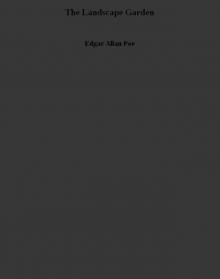 The Landscape Garden
The Landscape Garden Complete Tales & Poems
Complete Tales & Poems Great Tales and Poems of Edgar Allan Poe
Great Tales and Poems of Edgar Allan Poe The Colloquy of Monos and Una
The Colloquy of Monos and Una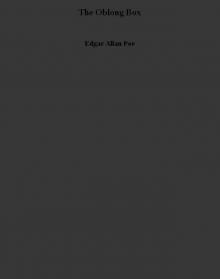 The Oblong Box
The Oblong Box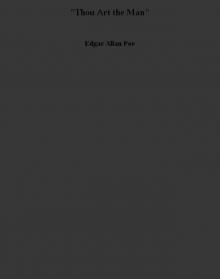 Thou Art the Man
Thou Art the Man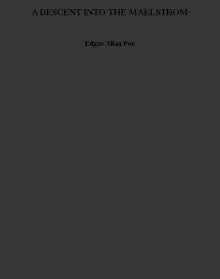 A DESCENT INTO THE MAELSTROM
A DESCENT INTO THE MAELSTROM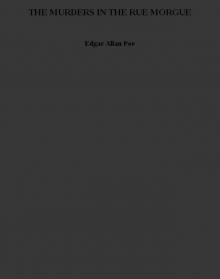 THE MURDERS IN THE RUE MORGUE
THE MURDERS IN THE RUE MORGUE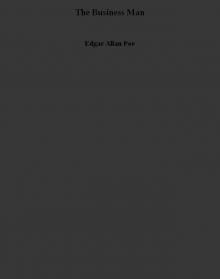 The Business Man
The Business Man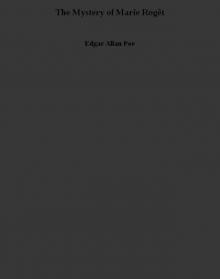 The Mystery of Marie Rogêt
The Mystery of Marie Rogêt Metzengerstein
Metzengerstein The Man That Was Used Up
The Man That Was Used Up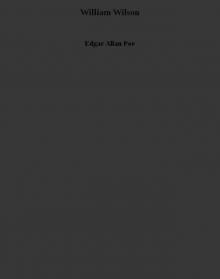 William Wilson
William Wilson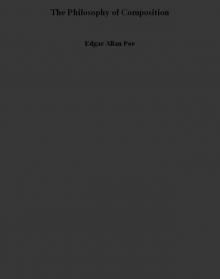 The Philosophy of Composition
The Philosophy of Composition The Portable Edgar Allan Poe
The Portable Edgar Allan Poe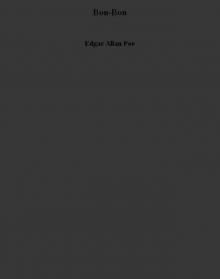 Bon-Bon
Bon-Bon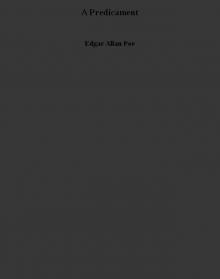 A Predicament
A Predicament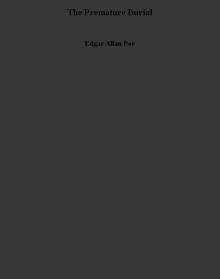 The Premature Burial
The Premature Burial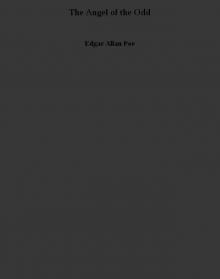 The Angel of the Odd
The Angel of the Odd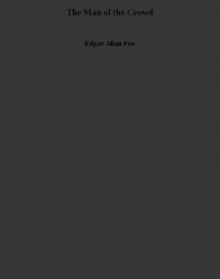 The Man of the Crowd
The Man of the Crowd Never Bet the Devil Your Head
Never Bet the Devil Your Head The Tell-Tale Heart and Other Writings
The Tell-Tale Heart and Other Writings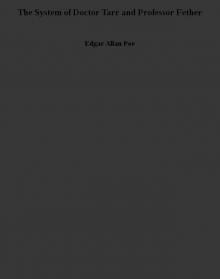 The System of Doctor Tarr and Professor Fether
The System of Doctor Tarr and Professor Fether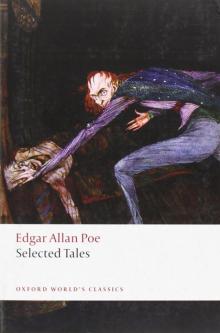 Selected Tales (Oxford World's Classics)
Selected Tales (Oxford World's Classics) Essential Tales and Poems of Edgar Allan Poe (Barnes & Noble Classics Series)
Essential Tales and Poems of Edgar Allan Poe (Barnes & Noble Classics Series) MS. Found in a Bottle
MS. Found in a Bottle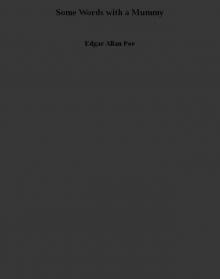 Some Words with a Mummy
Some Words with a Mummy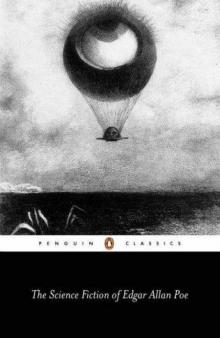 The Science Fiction of Edgar Allan Poe (Penguin Classics)
The Science Fiction of Edgar Allan Poe (Penguin Classics)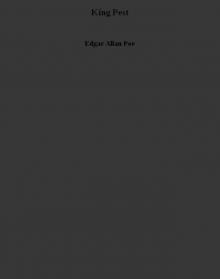 King Pest
King Pest CRITICISM
CRITICISM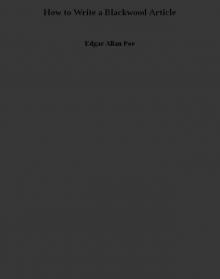 How to Write a Blackwood Article
How to Write a Blackwood Article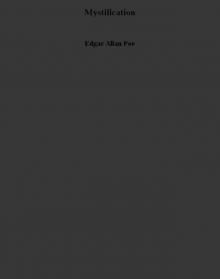 Mystification
Mystification Diddling Considered as One of the Exact Sciences
Diddling Considered as One of the Exact Sciences Steampunk Poe
Steampunk Poe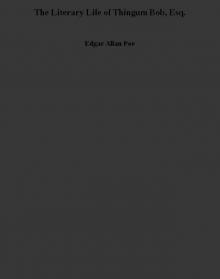 The Literary Life of Thingum Bob, Esq.
The Literary Life of Thingum Bob, Esq. Classic Crime Collection
Classic Crime Collection Complete Stories and Poems of Edgar Allen Poe
Complete Stories and Poems of Edgar Allen Poe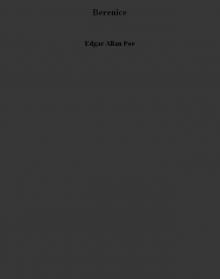 Berenice
Berenice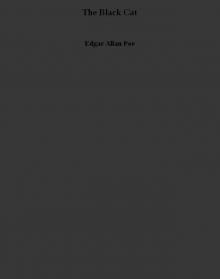 The Black Cat
The Black Cat The Slender Poe Anthology
The Slender Poe Anthology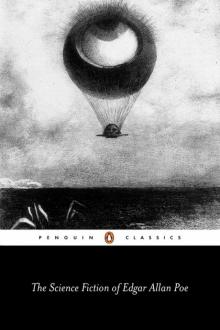 The Science Fiction of Edgar Allan Poe
The Science Fiction of Edgar Allan Poe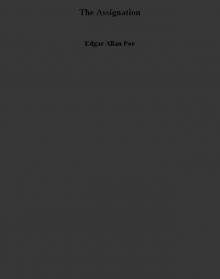 The Assignation
The Assignation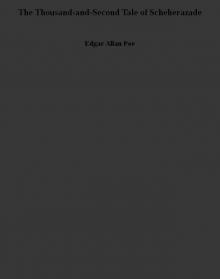 The Thousand-and-Second Tale of Scheherazade
The Thousand-and-Second Tale of Scheherazade The Raven and Other Short Stories
The Raven and Other Short Stories The Spectacles
The Spectacles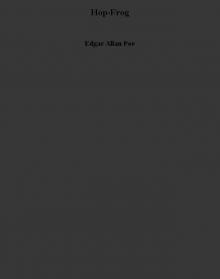 Hop-Frog
Hop-Frog The Purloined Letter
The Purloined Letter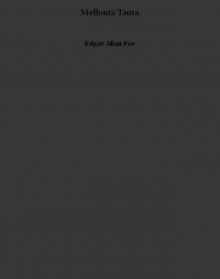 Mellonta Tauta
Mellonta Tauta The Balloon-Hoax
The Balloon-Hoax Landor's Cottage
Landor's Cottage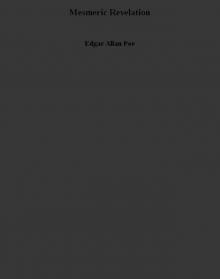 Mesmeric Revelation
Mesmeric Revelation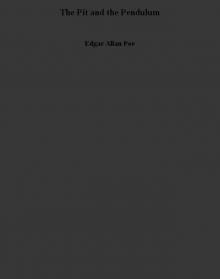 The Pit and the Pendulum
The Pit and the Pendulum